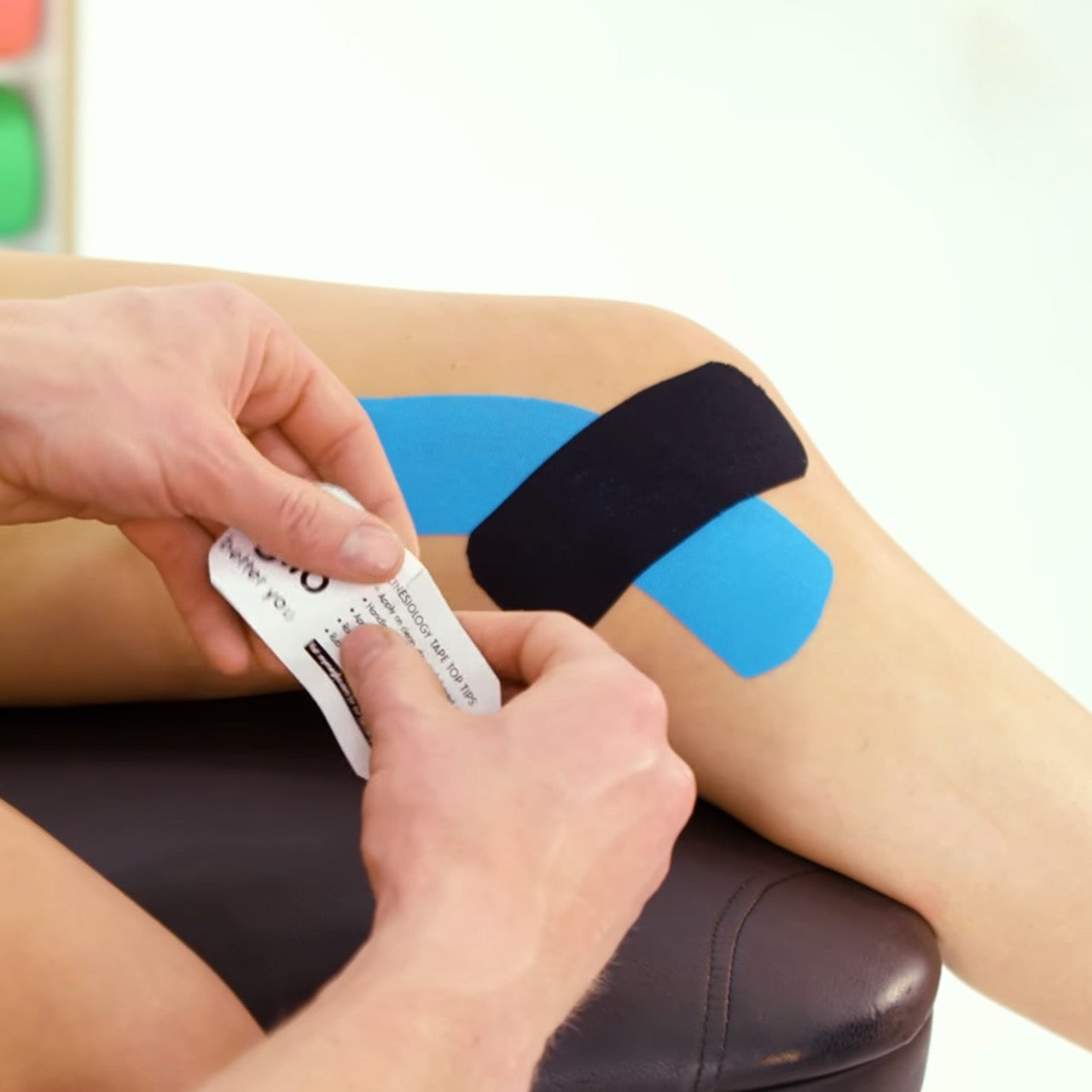Knieschmerzen sind weit verbreitet. Sie können jeden treffen, vom Sportler bis hin zu Menschen mit einem eher sitzenden Lebensstil. Knieschmerzen aufgrund von Verletzungen, Überbeanspruchung oder Arthritis können die Lebensqualität erheblich beeinträchtigen. Kinesiologie-Tape ist eine beliebte Methode zur Behandlung von Knieschmerzen. Dieses elastische Tape ist bei Physiotherapeuten und anderen Bewegungsexperten beliebt, da es Halt bietet, Schmerzen lindert und die Beweglichkeit verbessert.
Lassen Sie uns die Vorteile des Kinesiologie-Tapings und die Anwendungsmethoden bei verschiedenen Knieverletzungen untersuchen.
Was ist Kinesiologie-Tape?
Kinesiologie-Tape, auch K-Tape genannt, ist ein therapeutisches Tape, das in den 1970er Jahren von Dr. Kenzo Kase entwickelt wurde. Es ist ein dehnbares Tape, oft aus Baumwolle, Polyester und elastischen Fasern. Im Gegensatz zu herkömmlichem Sporttape ermöglicht Kinesiologie-Tape volle Bewegungsfreiheit. Es imitiert die Elastizität der Haut und bietet gleichzeitig Halt.
Hilft Kinesiologie-Taping bei Knieschmerzen?
Ursachen für Knieverletzungen können sein:
- Unter- oder Übertraining
- Plötzliches Trauma
- Probleme mit der Kniemechanik
Sie kommen häufig im Sport vor, insbesondere bei plötzlichen Stopps, Richtungswechseln oder direkten Belastungen des Knies. Knie-Taping kann die Kniestabilität verbessern und beim Training Halt geben.

HINWEIS: Für eine ordnungsgemäße Diagnose und Behandlung holen Sie immer ärztlichen Rat ein.
Einige häufige Knieverletzungen, die durch kinesiologisches Taping behandelt werden können, sind:
Arthrose
Arthrose ist eine häufige Ursache für Knieschmerzen. Sie schädigt den Knieknorpel, wodurch die Knochen aneinander reiben. Sie ist die häufigste Form der Arthritis und verursacht Schmerzen und Steifheit, was alltägliche Bewegungen erschwert.
Eine Studie aus dem Jahr 2023 im Irish Journal of Medical Science ergab, dass Kinesiologie-Taping in Kombination mit Physiotherapie Kniearthrose im Vergleich zu alleiniger Physiotherapie linderte. Nach sechs Wochen Physiotherapie und Kinesiologie-Taping verbesserten sich bei den 40 Teilnehmern Schmerzen, Beweglichkeit und körperliche Leistungsfähigkeit.
Eine Studie aus dem Jahr 2017 mit 42 Teilnehmern ergab ähnliche Ergebnisse. Sie verwendeten einen Monat lang Kinesiologie-Taping oder ein Placebo. Die Forscher fanden heraus, dass Kinesiologie-Tape kurzfristig bessere Auswirkungen auf das Gehen, Schmerzen und den Bewegungsumfang der Kniebeugung hatte.
Bänderverletzungen
Überdehnung und Belastung der Knie über ihre normale Belastbarkeit hinaus können Bänderverletzungen verursachen. Im Sport können Kniebänderverletzungen durch einen direkten Schlag auf das Knie, eine Verdrehung des Knies und Überbeanspruchung entstehen. Am häufigsten sind das vordere Kreuzband (ACL), das hintere Kreuzband (PCL) und das mediale Kreuzband (MCL) betroffen.
Kinesiologisches Taping wird häufig zur Vorbeugung oder Behandlung von Kniebandverletzungen eingesetzt. Es hilft, das Knie zu stabilisieren, Schmerzen zu lindern und die Beweglichkeit zu verbessern.
Eine Studie ergab, dass kinesiologisches Taping dazu beitragen kann, erneute Kreuzbandverletzungen zu verhindern . Die Forscher fanden heraus, dass kinesiologisches Taping nach einer Kreuzbandrekonstruktion den Valguswinkel des Knies reduziert. Dies verringert das Risiko einer Folgeverletzung.
Eine ähnliche Studie aus dem Jahr 2016 umfasste 30 Personen, die sich einer Kreuzbandoperation unterzogen hatten. Sie wurden einer Kinesiologie-Taping-Gruppe oder einer Scheinkontrollgruppe zugewiesen. Die Ergebnisse zeigten, dass Kinesiologie-Taping neben der Standardrehabilitation Schmerzen und Schwellungen lindert und gleichzeitig den Bewegungsbereich der Kniebeuge und die Kraft der Oberschenkelmuskulatur verbessert.
Patellofemorales Schmerzsyndrom (PFPS oder Läuferknie)
PFPS ist eine Kniegelenksverletzung, die durch Überbeanspruchung, Fehlstellung oder Ungleichgewicht der Kniestützmuskulatur verursacht wird. Die Schmerzen treten an der Vorderseite des Knies, im Bereich der Kniescheibe oder Patella, auf. Sie treten häufig bei Sportarten mit vielen plyometrischen Bewegungen auf, wie Laufen und Springen, daher der Spitzname. Kinesiologisches Taping kann bei Läuferknie helfen, indem es die Kniescheibe ausrichtet und die Patellasehnen stützt.
Andere häufige Ursachen für Knieschmerzen sind:
- Schleimbeutelentzündung
- Chondromalazie der Kniescheibe
- Tractus iliotibialis (IT-Band-Syndrom)
- Muskelrisse
- Sehnenentzündung
3 gängige Kinesiologie-Taping-Techniken bei Knieschmerzen
HINWEIS: Für eine ordnungsgemäße Diagnose und Behandlung holen Sie immer ärztlichen Rat ein.
Laden Sie unseren kostenlosen Leitfaden herunter
Taping bei Läuferknie
- Bereiten Sie einen Y-Streifen-Abschnitt des Klebebands für die Vorderseite des Knies vor.
- Reißen Sie ein 2–3 cm langes Stück des Trägerpapiers vom Klebeband ab. Dies wird Ihr Anker.
- Platzieren Sie diesen Anker auf halber Höhe des Quadrizepsmuskels, ohne ihn zu dehnen.
- Ziehen Sie das restliche Trägerpapier ab. Dehnen Sie das Klebeband leicht, während Sie es in Richtung Kniescheibe auf Ihre Haut legen. Positionieren Sie die geteilten Abschnitte um die Kniescheibe herum.
- Legen Sie die letzten 2–3 cm jedes Arms des Y-Streifens ohne Dehnung zusammen auf die Patellasehne. Dadurch wird das Ende des Tapes fixiert.
ANSEHEN: Unsere Videoanleitung zum allgemeinen Knie-Taping.
Taping bei Schmerzen an der Innenseite des Knies
- Bereiten Sie einen I-Streifenabschnitt des Klebebands vor.
- Reißen Sie ein 2–3 cm langes Stück des Trägerpapiers vom Klebeband ab. Dies wird Ihr Anker.
- Platzieren Sie Ihren Anker direkt unterhalb der Mitte des Knies, ohne eine Dehnung anzuwenden.
- Dehnen Sie das Tape um 25 % und legen Sie es fest auf die Haut.
- Lassen Sie abschließend 2–3 cm Klebeband übrig, um es ohne Dehnung als gegenüberliegenden Anker festzukleben.
- Bereiten Sie zwei kürzere Klebebandstücke vor.
- Bringen Sie sie in einem X-Muster über dem bereits angebrachten Klebeband an. Verwenden Sie an beiden Enden 2–3 cm als Ankerpunkte ohne Dehnung und wenden Sie in den mittleren Bereichen 50 % Dehnung an.
ANSEHEN: Unsere Videoanleitung zum Tapen der Knieinnenseite.
Tapen bei Schmerzen an der Knieaußenseite
- Bereiten Sie einen I-Streifenabschnitt des Klebebands vor.
- Reißen Sie ein 2–3 cm langes Stück des Trägerpapiers vom Klebeband ab. Dies wird Ihr Anker.
- Platzieren Sie Ihren Anker an der Außenseite des Knies direkt unter der Kniescheibe, ohne eine Dehnung anzuwenden.
- Dehnen Sie das Tape um 25 % und legen Sie es bis etwa zur Hälfte des Oberschenkels fest auf die Haut.
- Lassen Sie abschließend 2–3 cm Klebeband übrig, um es ohne Dehnung als gegenüberliegenden Anker festzukleben.
- Bereiten Sie zwei kürzere Klebebandstücke vor.
- Kleben Sie die Tapes in einem X-Muster über das bereits angebrachte Tape an der Außenseite des Knies, wo die Schmerzen auftreten. Verwenden Sie an beiden Enden 2–3 cm als Ankerpunkte ohne Dehnung und strecken Sie die mittleren Bereiche um 50 %.
ANSEHEN: Unsere Videoanleitung zum Tapen der Knieaußenseite.
Welches Band soll ich kaufen?
Verschiedene Anbieter bieten Kinesiologie-Tape in vielen Farben, Längen und Breiten an. Es ist auch als ungeschnittene oder vorgeschnittene Streifen oder Rollen erhältlich.
Eine kleinere Rolle ist am besten geeignet, wenn Sie Kinesiologie-Tape gelegentlich für den persönlichen Gebrauch verwenden. Eine größere Rolle ist besser, wenn Sie häufiger tapezieren müssen oder Klienten in einem klinischen Umfeld tapezieren.
Über Meglio K-Tape
Das Meglio Kinesiologie-Tape wurde in Zusammenarbeit mit Physiotherapeuten und Sportwissenschaftlern entwickelt. Es ist leicht, flexibel und wasserabweisend. Da es latexfrei ist und aus natürlicher Baumwolle besteht, ist es für die meisten Hauttypen geeignet. Bei richtiger Anwendung bietet das Meglio Kinesiologie-Tape bis zu fünf Tage flexiblen Halt.
Unser Kinesiologie-Tape ist 5 cm breit und als 5-m-Rolle oder als 31,5-m-Rolle erhältlich .
Sind Sie bereit, Ihre Kniepflegeroutine zu verbessern? Entdecken Sie das gesamte Sortiment der Meglio-Kinesiologie-Tapes .







